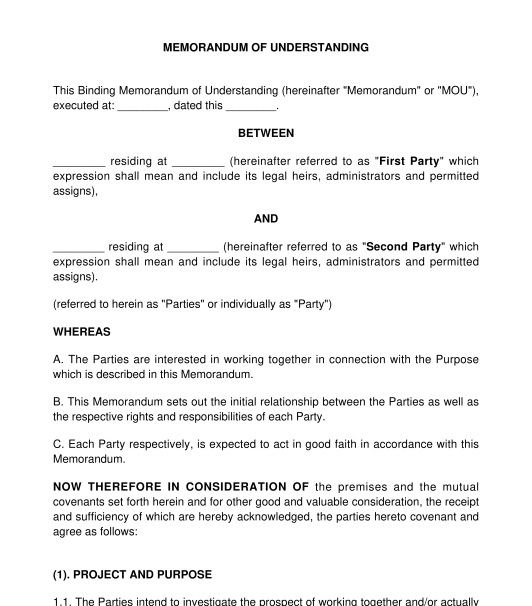 01-04-2025
01-04-2025

Answer a few questions and your document is created automatically.

Your document is ready! You will receive it in Word and PDF formats. You will be able to modify it.




Rating: 4.6 - 122 votes
Fill out the templateAn MoU is an agreement between two or more parties that outlines the terms of a proposed agreement or collaboration. It is intended as a starting point for the Parties, as it enables them to set out a preliminary understanding between one another and can help them work towards a more formal agreement.
Having a written MoU helps the parties avoid communication gaps and misunderstandings without entering into a formal and more complicated agreement. MoU also helps create trust between the parties for collaboration or projects.
There are various types of MoUs used based on the type and situation of the transactions, but generally, the structure of all these documents is the same. Different names are interchangeably used for MoU including "Letter of Intent" or "Memorandum of Agreement".
Since most of the MoUs are non-binding, a separate Non-Disclosure Agreement can be signed to protect secret information, documents or other materials disclosed to each party.
No, having an MoU is not mandatory. However, having a clearly written MoU will help in establishing a clear understanding between the parties before entering into a formal agreement.
The parties to a Memorandum of Understanding may be individuals, companies, or other entities like LLP, NGO etc. The parties to the agreement must be above the age of 18 years to be a valid agreement. A company or other legal entity registered in India or other countries can also enter into a MoU.
The duration of the MoU varies and the parties involved decide the duration of the MoU. It can be for a fixed period such as 6 months or 3 years. Some MoUs contain a provision to automatically renew for a specific period unless it is terminated by either party as per the terms of the MoU.
The Memorandum of Understanding should be signed by all parties and each party shall be provided with a copy of the MoU.
If the signatory is signing the MoU on behalf of a company or entity, it is necessary to ensure the authenticity of the signatory and attach a Power of Attorney or a Board Resolution as per the situation.
When signing the MoU the parties shall hand over the copies of all relevant documents related to the proposed transaction or project.
This Memorandum can be chosen to be legally binding or non-binding.
In the first case, the Memorandum acts as a general agreement between the Parties which covers the broad understanding of the Parties. Often, Parties may sign a Memorandum of Understanding outlining some general agreement and then will go away and make some further investigations before working out the finer details.
If it is chosen to be non-binding, the Parties may not actually be legally obliged to comply with it. This is because in many cases, Parties may not actually be certain about the specific terms on which they can agree, but they still find it beneficial to put something in writing, outlining some broader goals (such as the general nature of the project), and confirming that they will act in good faith in pursuit of those goals.
A Memorandum of Understanding must include the following clauses:
If the Memorandum is binding, the principles of contract law and the Indian Contract Act, 1872 will apply to it.
If the Memorandum is not legally binding, there is no law that directly applies to it. However, ordinary principles of contract law, as provided by common law, may be applied in interpreting, and understanding the agreement between the Parties.
In the event that a Party acts in bad faith, causing another Party to suffer loss, then general principles of equity, estoppel, or laws dealing with misleading and deceptive conduct may become relevant.
The MoU may come under the relevant laws considering the objectives and areas it is related to. For example, if the MoU is related to real estate, the Transfer of Property Act, 1882 and Real Estate (Regulation and Development) Act, 2016 may be applicable.
You fill out a form. The document is created before your eyes as you respond to the questions.
At the end, you receive it in Word and PDF formats. You can modify it and reuse it.
A guide to help you: What to do after Finishing a Contract?
Memorandum of Understanding - Template - Word & PDF
Country: India